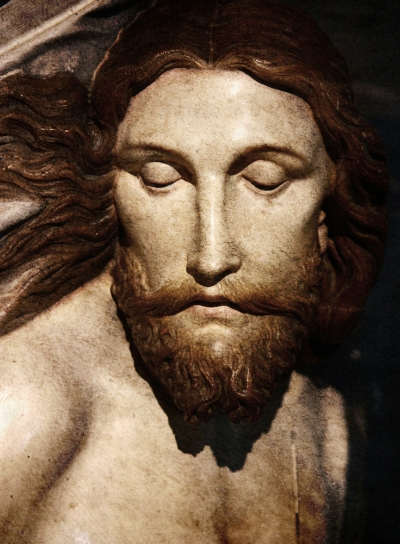A Spiritual Thought Experiment: Saving Jesus from God’s Plan
Part One

Scientists often utilize what they call a thought experiment. You don’t mix chemicals in a lab or inject the DNA of one thing into another. Rather, you imagine a situation, add this and that, and then think about what might happen. Such an approach to a situation seems as though it would be very helpful in understanding theological questions, and so I would like to apply a thought experiment to Christian theology. The scene is quite simple. Suppose it is a Sunday morning, and four different individuals turn off the sidewalk and decide to walk into a church and participate in the service. One person is a student at the college in town and is searching for a meaningful framework for his life, be it Christianity, Buddhism, atheism, or some comparable philosophy. The second person is actually a couple who are beginning to think about spiritual guidance for their two young children. They are fully aware that part of growing up is asking questions about God, death, and love, and unsure themselves, they figure a little churchy help can’t hurt. The third person is what John Shelby Spong called a member of the church Alumni Club. Used to be a member of a church, couldn’t deal with the thinking she found there and left. But recently, she has heard that the church has become a lot more progressive and is back for a second look. The fourth person is quite elderly. Having been that searching student, that concerned parent, as well as the second looker, time has raised to the existential level the questions of the meaning of life, the inevitability of its earthly end, and the existence of God. All four persons are thinking that today, perhaps, the light will shine, and the answer will come.
The church they individually and quietly enter is mainline Protestant, a landmark in town for generations, losing members, and struggling with the budget. It is not a fundamentalist evangelical place, with a prancing preacher calling souls to come forward to be saved, but rather a gathering that includes the old liturgy, singing hymns, mostly old, but some new, focused on the sermon and the coffee hour that comes later. And who is this preacher-pastor? Although it could be a woman, let us assume that the pastor is a married man in his 50s. He went to seminary, took all the required courses in church history, Bible, and theology, learned a little counseling, and has been called and served at three different churches in his career. Socially he is liberal and theologically traditional/conservative. In addition to referencing current issues in his sermons, he likes to follow the church calendar, preaching about the major events or ideas in the early life of the church.
With the big day – Easter- coming up on Sunday, our four visitors thought it would help their search to go to church on Good Friday. After all, there is all this talk in church circles about the death and resurrection of Jesus and how Jesus died for your sins, and all that, so Good Friday sounded pretty important. The first thing they discovered or remembered was that not a whole lot of people even think about being in church on the day that commemorates the crucifixion of Jesus, so attendance was very sparse. The elements of the story were related pretty straightforwardly, describing both Jesus and also events that accompanied his death. He suffered. He asked the Father to forgive those crucifying him. He cried out to God, feeling forsaken. The sky grew dark. The curtain of the Temple was torn in two. The earth shook, rocks split, tombs opened, and the bodies of many people were raised from the dead. The gospel stories without question present the crucifixion of Jesus as a truly cosmic event, impacting the very structure of nature itself, including humanity. And on a subject of such grave import, in church that day, no one spoke a critical word. It was all taken as gospel truth.
But, we ask, did all that really happen? The pastor preacher certainly seemed to take it all; literally, the culmination of a weeklong series of events beginning with the Entry into Jerusalem a week earlier, followed by overturning the tables in the temple, Last Supper, arrest in Gethsemane, presence before Pilate, interrogation and sentencing.
Our four visitors walked out of church more confused than when they had walked in. Is this something I want my children to believe? Do Christians really believe that story? Can I believe it myself? Determined to get some answers, all four gave themself a homework assignment for the week, namely, you guessed it, to study up on the crucifixion story. We don’t have time here to look at the various resources they went to, but we can summarize the results from the various articles, books, encyclopedias, blogs, and websites.
A lot of the commentary tried to give symbolic meaning to the words. For example, the Temple curtain was not really torn. The imagery is an attempt on the part of the early church to say that The Way of Jesus now replaces Judaism. There was no earthquake, but the crucifixion is much more than a single historical event. Bodies did not rise out of tombs, but the death of Jesus is the sign that new life has arrived. And so on. The images point to a deeper reality and were never intended to be taken literally.
But the biggest revelation gathered from the reading was that, aside from the crucifixion itself, it is quite possible, if not probable, that none of what we ascribe to the last week of Jesus’ life ever happened. Tens of thousands of Jews flocking to Jerusalem at Passover was a recipe for rebellion, and Pilate, being the ruthless governor he was, allowed no possibility for trouble to even begin. He most likely had issued standing orders to arrest and crucify anyone who posed a threat, and Jesus was a ready suspect and target. But it went beyond keeping order, because Jesus posed a threat not only to Rome, but also to all the rich and powerful who controlled and benefitted from the patronage/patriarchal system. Jesus had continually condemned the oppression of the poor by the rich, such that the wealthy and powerful were desperate to get rid of him. Passover proved the perfect moment, when the suspicion of sedition would provide ample opportunity to dispose of him and the threat he posed.
But more had to be done. It was one thing for the monied elite who worked with Pilate to have Jesus crucified. It was quite another to make that execution palatable to the many who followed him. And so, over time, talking years, the crucifixion of Jesus came to be presented, not as the cruel execution of a troublemaker, but as God’s plan of salvation for the faithful of the earth. The fabricated details of this cosmic event were established by the time the gospels were written, and so the final story is the embellished story, torn temple curtain, earthquake, and all. It’s not that all that happened, but that the gospel writers tell it to underscore the significance of the crucifixion. But we must take it one step further, and realize that the centrality of the crucifixion, as key to the divine plan of salvation, was a fabrication of the rich and powerful created to replace the simple truth that Jesus was executed because he opposed the oppression of the poor by those very same elite. It is not enough to look for the “meaning” of the story. We must also see that the story itself has shifted from fighting oppression to satisfying the supposed divine anger.
How did the wealthy accrue the power to change the thinking of the church about who Jesus was and what he did? That, our four researchers discovered, is -up to now- a mystery hidden in history. But the fact is, that if you examine the thinking of the various church congregations at the end of the first century, theology that is ultra-conservative has crept back into the movement started by Jesus, both politically and religiously. The First Letter of Timothy is a prime example, wherein it is stated, without qualification, that slaves must obey masters, women must obey men, and everyone must obey those in authority. And the heart of this conservative perspective was the idea that the death of Jesus was not the execution of a revolutionary, but the essence of God’s plan. A tragic transition, indeed.
Dr. Carl Krieg received his BA from Dartmouth College, MDiv from Union Theological Seminary in NYC, and Ph.D. from the University of Chicago Divinity School. He is the author of What to Believe? the Questions of Christian Faith, The Void and the Vision and The New Matrix: How the World We Live In Impacts Our Thinking About Self and God. As professor and pastor, Dr. Krieg has taught innumerable classes and led many discussion groups. He lives with his wife Margaret in Norwich, VT.

